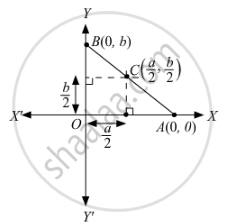Advertisements
Advertisements
प्रश्न
In Q.No. 1, write the distance between the circumcentre and orthocentre of ∆OAB.
उत्तर
The coordinates of circumcentre of a triangle are the point of intersection of perpendicular bisectors of any two sides of the triangle.

Thus, the coordinates of the circumcentre of triangle OAB is \[\left( \frac{a}{2}, \frac{b}{2} \right)\], as shown in the figure.
We know that the orthocentre of a triangle is the intersection of any two altitudes of the triangle.
So, the orthocentre of triangle OAB is the origin O(0, 0).
\[\therefore\] Distance between the circumcentre and orthocentre of ∆OAB = OC
\[\Rightarrow OC = \sqrt{\left( \frac{a}{2} - 0 \right)^2 + \left( \frac{b}{2} - 0 \right)^2} = \frac{\sqrt{a^2 + b^2}}{2}\]
APPEARS IN
संबंधित प्रश्न
The vertices of a triangle ABC are A (0, 0), B (2, −1) and C (9, 2). Find cos B.
Four points A (6, 3), B (−3, 5), C (4, −2) and D (x, 3x) are given in such a way that \[\frac{\Delta DBC}{\Delta ABC} = \frac{1}{2}\]. Find x.
The points A (2, 0), B (9, 1), C (11, 6) and D (4, 4) are the vertices of a quadrilateral ABCD. Determine whether ABCD is a rhombus or not.
Find the coordinates of the centre of the circle inscribed in a triangle whose vertices are (−36, 7), (20, 7) and (0, −8).
The base of an equilateral triangle with side 2a lies along the y-axis, such that the mid-point of the base is at the origin. Find the vertices of the triangle.
Find the distance between P (x1, y1) and Q (x2, y2) when (i) PQ is parallel to the y-axis (ii) PQ is parallel to the x-axis.
Find the locus of a point equidistant from the point (2, 4) and the y-axis.
Find the equation of the locus of a point which moves such that the ratio of its distances from (2, 0) and (1, 3) is 5 : 4.
A point moves so that the difference of its distances from (ae, 0) and (−ae, 0) is 2a. Prove that the equation to its locus is \[\frac{x^2}{a^2} - \frac{y^2}{b^2} = 1\]
Find the locus of a point such that the sum of its distances from (0, 2) and (0, −2) is 6.
Find the locus of a point which is equidistant from (1, 3) and the x-axis.
Find the locus of a point which moves such that its distance from the origin is three times its distance from the x-axis.
A (5, 3), B (3, −2) are two fixed points; find the equation to the locus of a point P which moves so that the area of the triangle PAB is 9 units.
Find the locus of a point such that the line segments with end points (2, 0) and (−2, 0) subtend a right angle at that point.
If A (−1, 1) and B (2, 3) are two fixed points, find the locus of a point P, so that the area of ∆PAB = 8 sq. units.
If O is the origin and Q is a variable point on y2 = x, find the locus of the mid-point of OQ.
What does the equation (x − a)2 + (y − b)2 = r2 become when the axes are transferred to parallel axes through the point (a − c, b)?
Find what the following equation become when the origin is shifted to the point (1, 1).
x2 + xy − 3x − y + 2 = 0
To what point should the origin be shifted so that the equation x2 + xy − 3x − y + 2 = 0 does not contain any first degree term and constant term?
Verify that the area of the triangle with vertices (2, 3), (5, 7) and (− 3 − 1) remains invariant under the translation of axes when the origin is shifted to the point (−1, 3).
Find what the following equation become when the origin is shifted to the point (1, 1).
xy − y2 − x + y = 0
Find what the following equation become when the origin is shifted to the point (1, 1).
xy − x − y + 1 = 0
Find the point to which the origin should be shifted after a translation of axes so that the following equation will have no first degree terms: y2 + x2 − 4x − 8y + 3 = 0
Find the point to which the origin should be shifted after a translation of axes so that the following equation will have no first degree terms: x2 − 12x + 4 = 0
The vertices of a triangle are O (0, 0), A (a, 0) and B (0, b). Write the coordinates of its circumcentre.
If the points (a, 0), (at12, 2at1) and (at22, 2at2) are collinear, write the value of t1 t2.
Write the coordinates of the circumcentre of a triangle whose centroid and orthocentre are at (3, 3) and (−3, 5), respectively.
Write the coordinates of the in-centre of the triangle with vertices at (0, 0), (5, 0) and (0, 12).
If the points (1, −1), (2, −1) and (4, −3) are the mid-points of the sides of a triangle, then write the coordinates of its centroid.
Write the area of the triangle with vertices at (a, b + c), (b, c + a) and (c, a + b).
